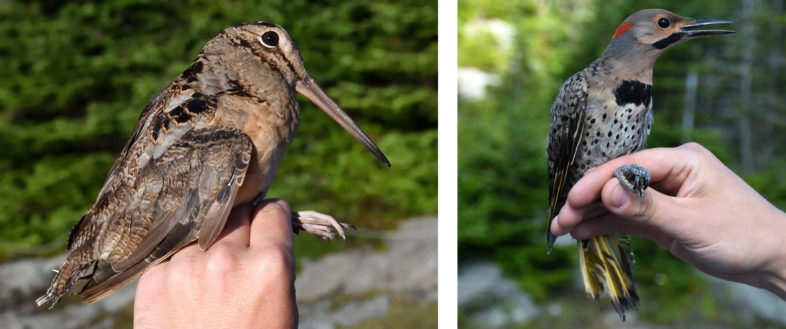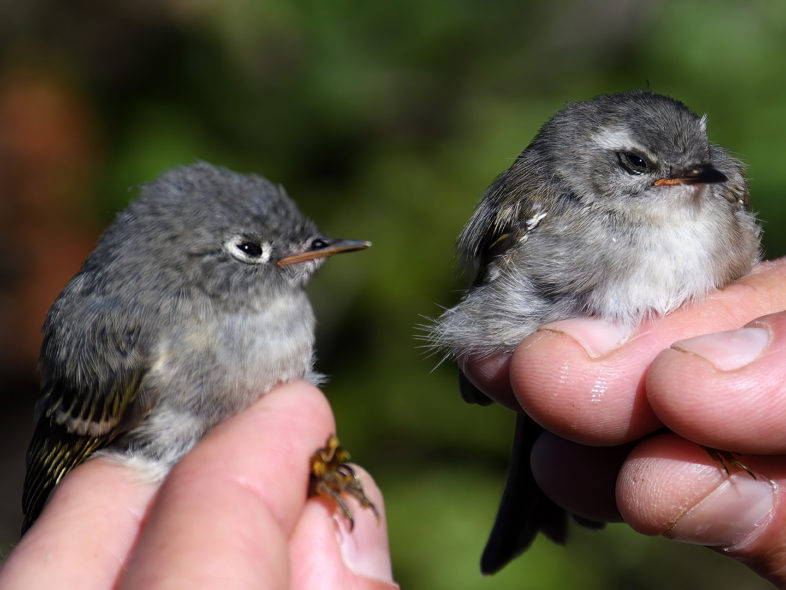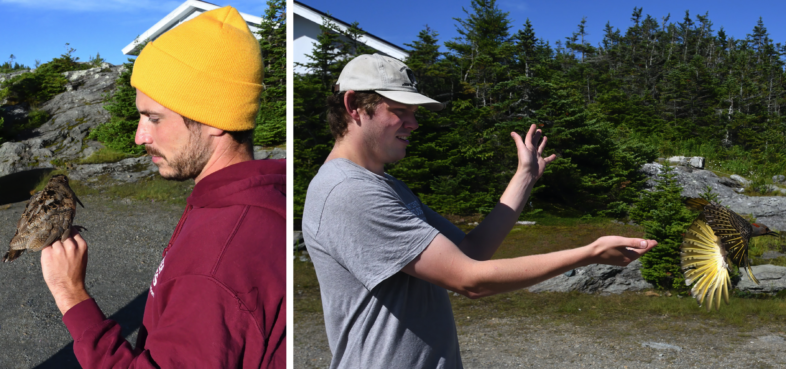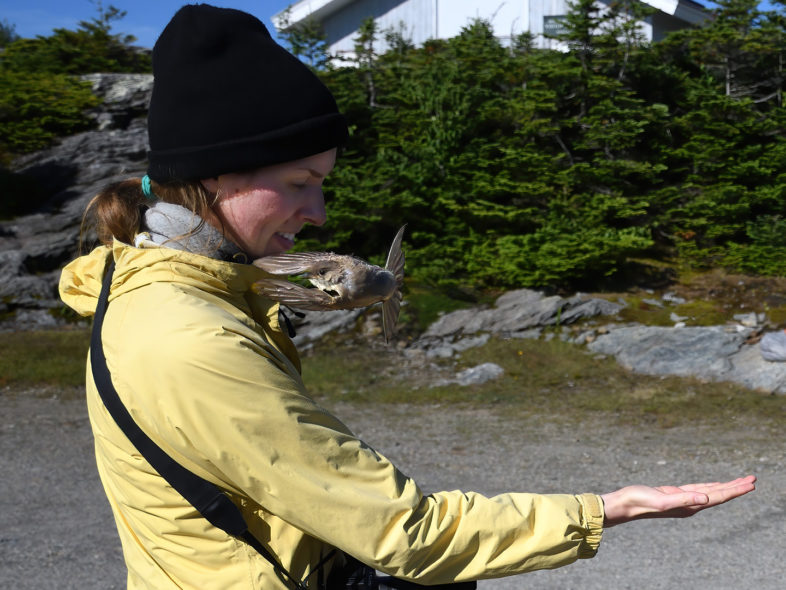
Two avian surprises in VCE’s mist nets on Mt. Mansfield: our first-ever American Woodcock (left) and only our second Northern (Yellow-shafted) Flicker capture (right). 27 July 2022 © Michael Sargent
Birds are usually the ones stealing the show on Mt. Mansfield; however, VCE staff took our own turn in the spotlight last week. An audio and camera crew from Vermont Public joined us on the ridgeline, braving slippery trails with cameras and microphones in hand to capture footage of VCE’s banding team in their element. The crew’s productions will spotlight VCE’s fieldwork on Mansfield and offer Vermonters a deep dive into our Bicknell’s Thrush conservation efforts.
When we hit the trails Tuesday afternoon, we hoped to soon showcase a handheld GPS-tagged Bicknell’s Thrush (BITH), while explaining to Vermont Public how this new dimension of our work will help further unravel the mysteries of BITH movements. Unfortunately, Mansfield’s ridgeline, which echoed with adult BITH songs only a few weeks earlier, remained eerily silent save for the whistled notes of several White-throated Sparrows. Even clumps of scrubby balsam firs where careful observers can frequently spot this charismatic songbird yielded few glimpses of dusty brown among the green needles. Thankfully, our trip was not wholly devoid of BITH—several spunky juveniles found their way into our nets alongside a flurry of warblers, kinglets, and juncos. These young birds may not have qualified for fitting with GPS backpacks this year, but they did provide an excellent opportunity to discuss BITH ecology and the importance of monitoring this vulnerable species with the Vermont Public crew.

Potentially foreshadowing VCE’s wrap-up banding session in mid-September, several juvenile Ruby-crowned (left) and Golden-crowned (right) Kinglets found their way into our nets on 27 July. © Michael Sargent
And, while the ridgeline may have been a far quieter place than it was a month earlier, we and our visitors were treated to a few avian surprises. As we wrap up our 31st consecutive field season on the mountain, VCE’s mist nets produced one of the most unexpected captures ever. Revered for their early spring courtship antics, American Woodcocks are among the least likely species to appear in a habitat dominated by stunted conifers and rock outcroppings. Yet, on Wednesday morning, during a routine net check, Brendan Collins was flabbergasted to find a long-billed, cryptically-plumaged sandpiper relative hanging in the bottom trammel of a net!
VCE’s media guests were also treated to another surprise avian star—a Northern (Yellow-shafted) Flicker. Although hardly a target species of our long-term banding efforts, this individual wasn’t the first flicker to find its way into our nets.

Nathaniel Sharp contemplates a banded (and very out-of-habitat) American Woodcock prior to release (left), while Kevin Tolan liberates a Northern (Yellow-shafted) Flicker (right). © Michael Sargent
While most birds we snare are newcomers to our nets, we do get the occasional recapture. This week, we recaptured a third highly unusual species for our montane forest site—an Eastern Phoebe. This juvenile was one of two individuals banded by our team the previous week. As for any recapture, we dutifully measured and weighed this errant phoebe before sending it on its way.

Emily Anderson releases another highly unusual, lowland species on Mansfield–an Eastern Phoebe. Surprisingly, this individual had been banded by VCE on the ridgeline one week earlier! © Michael Sargent
Our two-day capture total of 69 birds included:
American Woodcock — 1 adult in heavy flight feather and body molt, VCE’s first-ever Mansfield capture of this species
Northern (Yellow-shafted) Flicker — 1; VCE’s second-ever ridgeline capture of the species
Eastern Phoebe — 1 recapture of first-year bird banded on 7/20 (another unusual species)
Ruby-crowned Kinglet — 2 free-flying juveniles
Golden-crowned Kinglet — 4 free-flying juveniles
Red-breasted Nuthatch — 1 free-flying juvenile
Winter Wren — 1 free-flying juvenile
Bicknell’s Thrush — 3 free-flying juveniles, including 1 banded on 20 July
Swainson’s Thrush — 1 female with regressing brood patch
American Robin — 1 female with fully-developed incubation/brood patch
Dark-eyed (Slate-colored) Junco — 22 (18 free-flying juveniles)
White-throated Sparrow — 5
Magnolia Warbler — 1 adult male
Blackpoll Warbler — 10 (5 free-flying juveniles)
Black-throated Blue Warbler — 1 yearling female, 1 yearling male
Yellow-rumped (Myrtle) Warbler — 13 (5 free-flying juveniles)
With days beginning to shorten and migrants in early stages of preparing for their long, southward journey, our 31st Mansfield season is drawing to a close. As I write, our biologists are preparing for one final excursion, crossing their fingers that a GPS-tagged BITH or two appear for an encore. Keep an eye out for our final summer update next week, and news on the Vermont Public stories!

The shining feathers on the flicker photo really breathtaking, thank you!
Hello
Have any idea when this segment, “news on the Vermont Public stories” broadcasts?
Thanks Gary
Love getting these reports and thankful for the work you’re doing.
More great stories from the top of Vermont!
Thanks to all who do this vital work.
Do we know yet when this is scheduled to be broadcast and how?
Hi everyone — we’re not sure when the Vermont Public pieces will air, but we will announce it when we do! Thanks for all your interest and great comments!